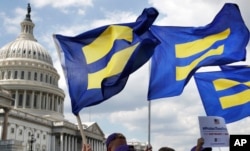U.S. President Donald Trump has issued an order banning most transgender people from serving in the military, except under “limited circumstances.”
A Friday night statement from the White House said the secretaries of defense and homeland security “have concluded that the accession or retention of individuals with a history or diagnosis of gender dysphoria — those who may require substantial medical treatment, including through medical drugs or surgery — presents considerable risk to military effectiveness and lethality.”
“Gender dysphoria” (formerly known as gender identity disorder) is defined by strong, persistent feelings of identification with the opposite gender and discomfort with one’s own assigned sex that results in significant distress or impairment.
The president pledged last year to block transgender people from joining the military, a move reversing former President Barack Obama’s policy of accepting them.
Trump’s push for the ban has been blocked by several legal challenges, and the Pentagon began allowing transgender recruits to seek enlistment in January.
Criticism swift
Criticism of the renewed effort towards a transgender ban was immediate from politicians, human rights groups and LGBT activists.
Democratic Leader Nancy Pelosi called the president’s ban “cowardly” and “disgusting.” She said the “hateful ban is purpose-built to humiliate our brave transgender members of the military. ... Once more, the President’s agenda of hate and prejudice is dictating our national security, instead of honor, decency and strength.”
The outcome of the new policy is likely to be “little more than stoking culture war,” said Gregory Angelo, president of Log Cabin Republicans, a Republican organization dedicated to representing LGBT conservatives and allies. He said his organization “commends the brave LGBT military personnel who put their lives on the line to keep us free and recommits to fighting for their freedoms.”
“What the White House has released tonight is transphobia masquerading as policy,” said Joshua Block, an ACLU senior staff attorney. “Transgender people in our military deserve more from their government than a myth-driven proclamation about their unfitness for full civic inclusion.”
Blake Dremann, president of SPART*A, an association of LGBT people who currently serve or have served in the U.S. Armed Forces and their families, said the average transgender service member has eight years of service and has been on two or more deployments.
“There is no justification for a ban, and there is no justification for leaving our country without service members who are capable and performing their duties to the standards set forth by our commanders,” Dremann said.
Lawsuit over ban
Transgender service members sued in August to try to block Trump’s original ban, and a U.S. district judge granted them an injunction, halting enforcement of it until the case is resolved.
Trump then signed a memorandum in August that directed the military not to accept transgender people as recruits and halted the use of government funds for sex-reassignment surgeries for active-duty personnel unless the process was already underway.
His memo called on Mattis to submit a plan by Feb. 21, 2018, on how to implement the changes.
In February, Pentagon spokesman Major Dave Eastburn confirmed to VOA that the secretary’s recommendation was sent to the president on Feb. 23. He did not discuss details of the guidance because it was a “private matter” between Mattis and Trump.
Pentagon correspondent Carla Babb contributed to this report.











